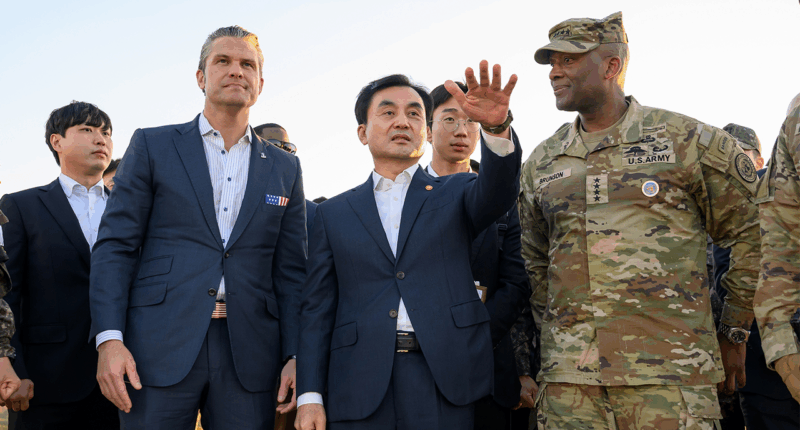Share this @internewscast.com
On Friday, North Korea conducted a ballistic missile test off its eastern coast, just days after U.S. War Secretary Pete Hegseth concluded a visit to South Korea. The visit had centered on strategies to deter North Korean threats and bolster the alliance between the U.S. and South Korea.
The South Korean Joint Chiefs of Staff reported that the missile, believed to be short-range, was launched from an inland location near Taekwan in the west, with a trajectory leading to the East Sea. The missile traveled approximately 435 miles, according to military officials in Seoul and Tokyo, as reported by Reuters and The Associated Press.
Japanese Prime Minister Sanae Takaichi confirmed there were no injuries or damages resulting from the launch. Additionally, South Korea’s military noted that they had observed preparatory activities before the launch and are keeping a close watch on any further developments in the region, The Associated Press reported.

U.S. War Secretary Pete Hegseth is pictured with South Korean Defense Minister Ahn Gyu-back during the 57th Security Consultative Meeting at the Defense Ministry in Seoul, South Korea, on Tuesday, November 4, 2025. (AP)
According to Reuters, North Korea has conducted multiple missile tests in recent weeks, showcasing what it describes as “cutting-edge” strategic weaponry.
During his three-day visit to South Korea on November 4, Hegseth addressed reporters following the annual security discussions with South Korean Defense Minister Ahn Gyu-back in Seoul. He expressed optimism regarding Seoul’s plans to increase defense expenditure and enhance its military forces. Hegseth noted that both nations agreed these investments would bolster South Korea’s capabilities in conventional deterrence against the North.
Hegseth added that President Donald Trump’s decision to support South Korea’s plans to build nuclear-powered submarines was driven by his desire to have strong allies. “And because Korea has been a model ally, he’s open to opportunities like that, that ensure they have the best capabilities in their own defense and alongside us as allies,” he said.

People watch a news program broadcasting a file image of a missile launch by North Korea, at the Seoul Railway Station in Seoul, South Korea, May 30, 2024. (Ahn Young-joon/AP Photo)
The United States and South Korea have maintained close military coordination as Pyongyang accelerates its weapons testing program. Hegseth’s visit was meant to reaffirm U.S. commitment to the alliance and emphasize deterrence against North Korea. His remarks in Seoul echoed earlier statements that the alliance will stay focused on deterring North Korea.
When asked whether the 28,500 U.S. troops stationed in South Korea might be used in conflicts beyond the peninsula, including with China, Hegseth said that protecting against nuclear-armed North Korea remains the alliance’s primary goal. “But there’s no doubt that flexibility for regional contingency is something we would take a look at,” he told reporters.

U.S. War Secretary Pete Hegseth, second from left, and South Korean Defense Minister Ahn Gyu-back, center, visit the Observation Post Ouellette near the border village of Panmunjom, South Korea, Monday, Nov. 3, 2025. (AP)
Friday’s launch underscores the fragile security situation on the peninsula and highlights ongoing tensions as North Korea continues to expand its missile capabilities. Both Seoul and Tokyo said they are analyzing the launch in coordination with the United States.
Reuters and The Associated Press contributed to this story.
















